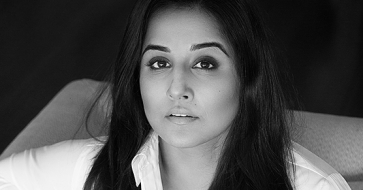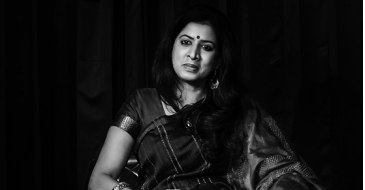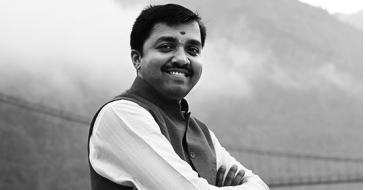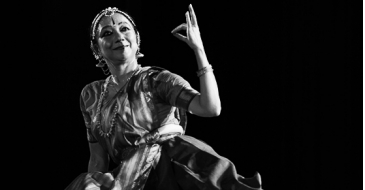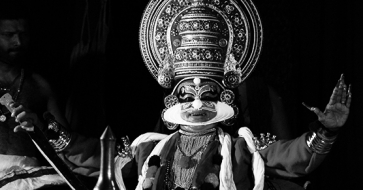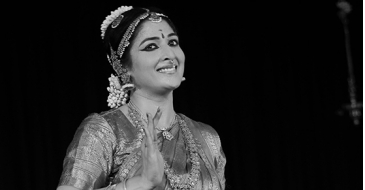In November last year, you presented a unique festival called Dhimahi where you created music for the margam (Bharatanatyam repertoire) in five unique talas. Just ahead of that, in the same year, you presented Chathurvidam, creative set of pieces of a Bharatanatyam margam, set to four different tala cycles — Sankeerna Jathi Triputa talam, Misra Jathi Jumpa talam, Chatusra Jathi Ata talam and Sankeerna Jathi Dhruva talam. What is your fascination with talams?
Even as a child, I used to move my fingers, toes and head in rhythm unconsciously. Then when I started learning dance I used to learn the jathi portions fairly quicker in comparison to the abhinaya segments. This apart, I've always wanted to explore avenues in my field that have hitherto been unexplored. Over time, I also came to realise that the talam factor was not given its due in many songs that were meant for dance. In the world of Carnatic music, Shruthi is revered as Matha or mother and Laya is respected as Pitha or father. So I wanted to specialise in this aspect.
What was the genesis of Dhimahi, your latest masterpiece and what is the kind of thought process that went into its creation and conception?
In the case of Carnatic music, we can refer to works of great saint-composers like Tyagaraja, Purandaradasa, Annamacharya, etc. There were notations for Tyagaraja krithis. However, for the 35 talams which are called Sulaadhi Saptha talams, nobody has taken an interest and documented their nuances up until now. Though I have written entire margams in all the 35 talams, I didn't have the opportunity to stage and present each margam before. When I tried doing research on them I could not find any references even on the internet.
This, in a sense, helped me in culminating my artistic instincts with my love for the Tamil language and the genesis of that was Dhimahi and Chathurvidham. Both these presentations consist of unique songs in different talams that have not been previously experimented with.
This fact has been acknowledged by many stalwarts and experts like in the field of Carnatic music and dance — Dr Balamuralikrishna, Sri T V Gopalakrishnan, Sri Umayalpuram Sivaraman, Sri Seshagopalan, Shri Neyveli Santhanagopalan, Sri Ghatam Karthick, Sri Narasimhachari, Smt Vasantha Lakshmi, Sri Dhananjayan, Smt Nandhini Ramani and a host of others.
I always follow simplicity in my style of writing music. What is the point if someone wants to prove their command with the English language by quoting words from Shakespeare, which many people don't even understand? My approach to writing is like that of Subramania Bharathi or Sri Rabindranath Tagore. Their words are simple, easy to understand and reach people
From a creative point of view, what is the most exciting and challenging part of envisaging a Bharatanatyam margam in a talam out of the ordinary or complex?
Usually 90 percent of music compositions come under the 4/8 rhythm cycle. Most film songs feature in this category. If you take Tisram for instance, which is 3/4, it will finish in three beats. But in the songs that were presented in Dhimahi, the talam consisted of either 9 beats, 11 beats, 13 beats, 22 beats, 29 beats or the longest talam, the Simha Nandhini Talam, which consists of 128 Aksharas (notes).
Needless to say, it is a challenge to write songs for such lengthy talams. It needs to suit the theme and appeal to the audience for them to enjoy the experience, effortlessly. Even a single akshara or rhythm cannot be missed and so it has to be handled with utmost care.
When I create work like this, it doesn't matter really if the work isn't appreciated. I need to ensure that there is no criticism, whatsoever, so I try to do whatever I do to the best of my ability. I can say now, with conviction, that both the events have been very successful.
Once you create work, someone else performs it, right? How challenging can it be for a learner? Can you give us an example or two?
Before I started my journey as a composer, I was a student learning the art from my guru and in awe of the whole concept of rhythm. Just like a child that learns the art of balancing on a cycle — after falling down a few times and getting bruised but not giving up until it succeeds — rhythm too requires a keen understanding of the idea of balance. Over time, one understands the right way to handle rhythm. Unfortunately, many people don't even venture into learning the skill of rhythm because it isn't easy to, at the start. But if you ask me, I'd say that everyone in the world of dance should attempt to understand and appreciate the intricacies of rhythm as dance is not all about bhava (emotion).
Rhythm has a very significant role to play. It feels good to create new jathis instead of remaining in a comfort zone and dancing only to existing jathis that have already been composed and performed, time and again.
Just like how we enhance the bhava segment by elaborating a sanchari in different ways with hand gestures and eye movements, we should also try and do so with rhythmic patterns. The sweet success in relishing the joy of composing a vibrant jathi can be compared to the emotions of a child who is thrilled to ride a bike after struggling to find balance, initially.
For a connoisseur or a rasika of dance, how does an experiment like this affect the experience of the dance?
For rasikas, this is like bliss! Even if the dance consists of 29 or more aksharas (notes), it needs to reach the rasika in a way that is easy and effortless.
Does it help that you understand dance in its entirety? You have a very keen understanding of music, you are a dancer and a choreographer. So when you are composing music, are you simultaneously envisioning its choreography and in a sense, dancing in your head. Does that make the process of composition easy? Is your music therefore multi-layered and are you in a way always multi-tasking?
Are my compositions easier to handle because I understand dance in all its entirety? The answer is not at all. My way of writing and composing is easy to understand because from the beginning I have been of the opinion that my songs should reach people. I also feel that the audience should not sit down and watch anything that we dance. We should be sensitive to their preferences and perform accordingly. Sri Subbudu, the famous dance critic, after attending a dance program that I had written the lyrics for and composed music, began his review thus: "Let all the credit go to that someone who wrote this play."
Almost 25 years ago, when this review was out, I was practically unknown. It was indeed a great compliment from one of the greatest critics of that time.
I always follow simplicity in my style of writing music. What is the point if someone wants to prove their command with the English language by quoting words from Shakespeare, which many people don't even understand?
My approach to writing is like that of Subramania Bharathi or Rabindranath Tagore. Their words are simple and easy to understand and it reaches people. Even Jawaharlal Nehru has mentioned that when a person is writing or speaking, the words should be simple and easily understood. I like to follow that philosophy.
You compose music essentially for dance; what constitutes its science and art. Many other composers of music for dance don't necessarily choreograph or dance. Do you feel you are in a position of advantage? If yes, how have you used it to the maximum?
I do envisage the choreography while composing its music. I have always been inspired by the work of masters like the Tanjore Quartet, Shri Papanasam Sivam and Dandayudhabani Pillai Sir who have paved the way of composing Alarippu, Jatiswaram, Varnam and other dance-related items. When we do a sanchari or a story, I am very particular about how it needs to be described in dance and this helps me in composing better.
The Tamil language, according to me, is very aesthetic and is embellished with excellent rhyme and vocabulary. So the choice of words is essential to bring out the rich beauty and flavour of the language.

I feel privileged to work on each and every song that I write while keeping all these factors in mind. Sometimes I even dance to check if it will be good to position a jathi or a swaram in a particular place. Apart from this, I would also like to mention that all my compositions adhere to the lakshanam format which basically means they are symmetrical in nature, unlike the lakshiya jathis that do not follow symmetry. If a girl adorns herself with earrings in only one of her ears, it will be odd, right? So balance is what I value as the most important aspect in all my compositions.
Being a dancer is definitely advantageous to me as a lyricist and is also an added asset while scoring music for dance pieces. To explain the science and art behind this more vividly, let me give an example. provisions in his store, right? He will, for instance, have no clue about hardware or software aspects of a computer. Or for that matter, someone who deals with computers would be clueless about provisions, right?
My nature was always to question whatever I was doing. Even if it was a simple calculation like 4 + 4 equals 8, I would question the reason behind it. As a result, I have always had to face brickbats; nevertheless it's always better to understand and do whatever you are doing, and well
I was a lot like that, initially. I knew only to dance but during the course of my artistic journey, I learnt the allied art forms of music and percussion. I also pursued my passion for Tamil and now the language and I are almost inseparable.
Further, as a performer, I began to understand the essence and importance of movements that are usually good on stage, and that in a sense, helped me in enhancing my compositions and my work, overall.
Nowadays mridangists, violinists, flautists and vocalists have started to compose for dance. Someone is writing the song and someone else is composing its music. When this happens, I feel the music loses its soul.
This is because when a percussionist composes a particular component, his focus is invariably on the rhythm; when a violinist composes, he tends to place more importance on the notes; similarly when a vocalist composes, he/she tends to give more attention to the musical notes. I consider myself to be doubly blessed in being a dancer and a composer.
Some of the students who performed at Dhimahi were very young; why do you feel that experiments like these are important even for young students?
I have deliberately featured young children and had them perform at Dhimahi. Children do not realise often that the fire will scorch them, and hence they do not hesitate to touch it. Likewise, they do not understand or analyse the calculations that go into the dance. They get excited listening to the audio and just want to dance to the song. It's only later that I explain the nuances to them. They just do as they are told. There is no fear in a child, so it makes my work easier; the process of choreography is also very seamless with them. When it comes to working with senior dancers, they tend to take time to warm up to intricate pieces and sometimes get uncomfortable with the complex use of talams.
A Pushpanjali composed by Madurai R Muralidharan for Dhimahi in ragam Hamsanandi set to Kanda Jathi Ata Talam
The music of Dhimahi is also available as CD for people to buy; why do you think this sharing is important for the world of dance, and music? Your music is widely accessible to dancers across the world. Was this decision conscious and how has this experience been?
Yes, it's a conscious decision to share my compositions with one and all. I think of it as a gift bestowed upon me by God and I am humbled by that. Whatever the Supreme has given me I want to return it to this world. If you ask me whether I have made good monetary benefits as a result of this sharing, the answer is a definite no.
When I started releasing my music in the form of CDs almost 25 years ago, there were hardly any in the market except for a few like that of Smt Vyjayanthimala and Guru Samaraj. Though the CD companies made money, the royalty that they paid to me annually was a pittance. I felt cheated that my work was not given its true value. So I decided to stop the sales through them. Now I have started using iTunes to market my compositions. And although the returns aren't substantial, owing to their reach worldwide, I prefer to use that channel to spread my music.
You are a storehouse of many identities. Which among them is closest to your heart?
I feel very happy that you think that I am a man with myriad identities but the reality may be different. I am still at crossroads as I don't think I am getting my due and rightful recognition either as a dancer, composer, musician, lyricist or a teacher. Even for Dhimahi, I didn't get any coverage from The Hindu although they did give me a small preview. Apart from my production, Sivagamiyin Sabhadam which The Hindu mentioned as a "zero-error program", none of my other big productions — such as Karna which I staged recently — have been considered worthy of a feature. The announcement of the awardees for the Kalaimamani title this year was yet another instance where I have been sidelined. Artistes who are much junior to me have been recognised but someone of my calibre who has composed almost 1,000 songs exclusively in Tamil has been overlooked. Even though I am not into awards or titles, recognition by your government is very important, especially when I apply for a US visa under the category of outstanding artistes. It is disappointing to me that my own government does not recognise my contribution towards our cultural heritage for the past so many years. More than me being identified as a versatile artiste, I want people to see me for the good person that I am which I feel is most important eventually.
My dream is not only to present the 35 margams in all 35 talams but also to become a trendsetter or an inspiration in this field. In case anyone attempts something new in this area, their venture will only be next to mine
When did you first realise that you wanted to keep pushing the creative envelope? Why is this process of innovation important for you?
Creativity and individuality are something that have been a part of my life, right from my early days. My parents used to constantly lecture me on using my own talent and potential instead of following someone else. It's good to have learnt from renowned and legendary personalities like Sri Muthiah Bhagavathar or Sri Kittappa Pillai among others but to say that I will only perform or teach what I have been taught is like reproducing the same. This is my opinion.
My nature was always to question whatever I was doing. Even if it was a simple calculation like 4 + 4 equals 8, I would question the reason behind it. As a result, I have always had to face brickbats; nevertheless it's always better to understand and do whatever you are doing, and well. Similarly if a person has already done something, I will think of ways of doing it differently. For example, if I want to go to Mylapore, I can go via Mandaveli, Luz Corner or Mount Road, right? So when there are many ways, I don't agree that there is only one way that I must follow. I have developed my own style without forgetting my roots or traditions. I am proud of that and I sincerely believe that one day this society will accept my work.
You are a man on the move; how and when do you compose and choreograph? How do you shut yourself from the noise of the world to be able to use math, science and art to create music that is complex, layered and soulful at the same time?
Whatever I may be doing or wherever I may be, there will always be a part of me thinking subconsciously of a line or a verse for a new song or a new jathi. I am composing even while I am talking to someone or when the milk man shouts or when the newspaper boy calls out or when my dogs bark and in the middle of all chaos. When I am traveling in a car, I record the song or jathi in the voice recorder. So in a way although I live in a world filled with the usual and mundane day-to-day things, there is another world that I go into when I compose. It's 200 percent true and I can vouch for it every day of my life. I live for music and rhythm. I have no explanation for this right now as to for whom or why I do all this, but I believe that my work will be useful as a reference and a benchmark in near future .
We hear your dream is to compose margams in all the 35 talas. How far are you from realising that and what's next on the anvil?
My dream is not only to present the 35 margams in all 35 talams but also to become a trendsetter or an inspiration in this field. In case anyone attempts something new in this area, their venture will only be next to mine. For example, if my daughter Kavya looks back at my work, she must be in awe and wonder about how and when she will be able to cross the ocean of artistic legacy that I have left behind. Coming to the 35 margams in 35 talams, the compositions are ready in all the talams from the Allarippu, Jathiswaram, Mallari, Varnam, Padam and Thillana. Now I am in the process of figuring out when to stage it. In the years to come, if any person presents the same, then their name will go down in the history of dance but only after mine!
Interviewed by Akhila Krishnamurthy
0 comments Comments





